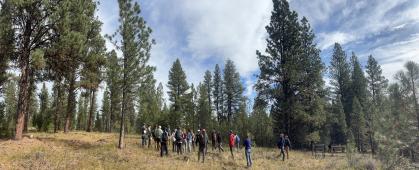When Montana State University educator-trainer Jeannie Chipps needed an authentic Montana research project to use as a model for teaching Proficiency Based Education, she turned to Montana NSF EPSCoR researcher Rob Payn. (Proficiency-based Education is also commonly known as Competency-based Education in that it assesses for students’ level of proficiency or competency in understanding and engaging the content being taught).
Chipps developed a summer professional development workshop for Montana STEM educators that used the work of Payn, an associate professor of Land Resources & Environmental Sciences at MSU, and his collaborators to model PBE assessment.
Chipps, a former high school chemistry teacher who now supports teachers through the Science Math Resource Center in MSU’s Department of Education, developed and taught the workshop to 15 teachers in July 2022. Her goal was twofold: to talk with teachers about ways we can use PBE to assess students with the newer science standards, and to root that conversation in a local Montana science phenomenon.
Chipps said PBE is a framework that helps not just teachers but entire school systems consider how we can personalize learning for students and transition from a traditional grading system to one that communicates learning as a proficiency level rather than a grade level.
“PBE is still rooted in state standards, but it gives students the ability to assess their own learning,” Chipps added. “It also communicates better to stakeholders what students truly know, compared to saying, for example, that a student achieved an 81% in a class.”
In 2021, the Montana Legislature passed the Transformational Learning Act in order to enhance “a flexible system of pupil-centered learning that is designed to meet the Montana Constitutional mandate of ‘fully develop[ing] the educational potential of each person.’” Montana State University has since offered courses and workshops on PBE to hundreds of in-service and pre-service teachers and will host a Summer PBE Institute in 2023.
Chipps worked directly with Payn to transform his research in the Judith River Watershed into a phenomenon-based scenario that helped model PBE for the STEM teachers. Payn looks at how the unique topography of the highly productive agricultural region may affect nitrogen runoff and how natural and man-made features impact nitrate levels found in waterways.
“A picture is truly worth 1,000 words,” said Chipps. “Rob shared an image that depicted land use at the border of two different properties. The river runs through these two properties but there were stark differences at the border. That sparks the conversation. When a teacher sees an image like that, they start looking for patterns, they think about cause and effect – all these cross-cutting concepts that we are supposed to demonstrate to our students.”
Chipps said she then accessed some of Payn’s published research articles and incorporated maps and a figure on the factors that impact nitrate levels into her teacher workshop.
“Rob gave me a way to ask a guiding question, which was an entry point into how do humans impact water quality within a specific location, and what other factors do we need to consider?” said Chipps. “This scenario works for all STEM teachers, too -- you can talk about water chemistry and use that in a chemistry classroom; you could talk about the ecosystems or agricultural practices and bring it into a life science or ag classroom; you could talk about geological influences in an earth science classroom.”
The teachers first studied the maps, diagrams and photos, then sketched their own models of what could be happening in the region. Chipps guided them and explained how their work dovetailed with PBE assessment.
Chipps said she was excited to see teachers bringing in their prior knowledge – a key component of PBE – to the workshop. Prior knowledge, for both teachers and students, can include content learned in another class as well as lived experiences, including social and cultural.
“I wanted to make sure that we were giving teachers a somewhat local phenomenon that they could connect with, and many people in Montana can connect with water-based phenomena. Given that we had access to researchers in that field, it made sense as a place to start the conversation,” she said.
Chipps will continue leading other classes and PD opportunities on Proficiency Based Education and plans to reach out to other EPSCoR and university faculty. The Science Math Resource Center is the primary Education-Outreach-Diversity partner at MSU for Montana NSF EPSCoR.
“It’s a great opportunity for researchers to bring their stories and their work to teachers, because teachers want to engage their students in that natural inquisitiveness to know the answer,” said Chipps. “Teachers have a curiosity that we want to spark in our students. Making it relevant, making it local, making it about something that they’ve heard of reignites that curiosity.”
To learn about future professional development opportunities for educators, subscribe to the STEM Educator Network newsletter.

